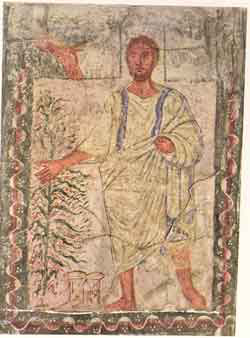The rise and fall of Solomon
The third and last king of the United Kingdom of Israel, Solomon, while not the heir apparent, becomes King David’s heir through the manipulation of his mother, Queen Bathsheva and Nathan the prophet. He begins his reign by asking God for wisdom. God responds to this impressive request by granting both wisdom and power. At first he uses these gifts to enrich the kingdom, culminating in the building of the Temple in Jerusalem, his capital. But in the end, he succumbs to the very temptations found in the book of Deuteronomy:
(טז) רַק֮ לֹא־יַרְבֶּה־לּ֣וֹ סוּסִים֒ וְלֹֽא־יָשִׁ֤יב אֶת־הָעָם֙ מִצְרַ֔יְמָה לְמַ֖עַן הַרְבּ֣וֹת ס֑וּס וַֽיהוה אָמַ֣ר לָכֶ֔ם לֹ֣א תֹסִפ֗וּן לָשׁ֛וּב בַּדֶּ֥רֶךְ הַזֶּ֖ה עֽוֹד׃ (יז) וְלֹ֤א יַרְבֶּה־לּוֹ֙ נָשִׁ֔ים וְלֹ֥א יָס֖וּר לְבָב֑וֹ וְכֶ֣סֶף וְזָהָ֔ב לֹ֥א יַרְבֶּה־לּ֖וֹ מְאֹֽד׃
(16) Moreover, he shall not keep many horses or send people back to Egypt to add to his horses, since יהוה has warned you, “You must not go back that way again.” (17) And he shall not have many wives, lest his heart go astray; nor shall he amass silver and gold to excess.
As a result, his kingdom declines and self-destructs.
The attraction of Solomon’s personality, among Jews, Christians and Muslims, produced a great number of legends, some only vaguely connected with the biblical material. Artists seem to have been greatly influenced by these folk tales, as well. For example, Solomon became the master of spirits and demons; especially, but not only, in Muslim art, this subject became central. Likewise, the queen of Sheba and her meeting with Solomon has been greatly embroidered in folk traditions and concomitantly in art. Of all the artistic treatments of King Solomon, the Judgment scenes are the most positive presentations of this king and the closest to the biblical account. We will begin our survey of art on King Solomon with this vignette.
The Judgment
In I Kings 3, after God grants the young Solomon the gift of wisdom, he is called upon to judge a difficult suit. Two prostitutes appear before him, with two newborns - one dead and one live. One of them claims that the dead infant at her breast is not hers, but was exchanged by her housemate, who had also just given birth. Each claims, “The live baby is mine.” How can Solomon bring justice to this painful scene? Shockingly, he orders the baby to be cut in two, instantly exposing the true character of each woman. The “true” mother renounces her claim to the child, while the other woman insists that neither should have the live baby. All Israel is stunned by the king's wisdom. The objective truth of the claims is never revealed; only the moral truth is important, endowing every law school with its first course in evidence.
We begin our visual examination with Gustave Doré’s melodramatic tableau, in order to compare it to other treatments of the scene.
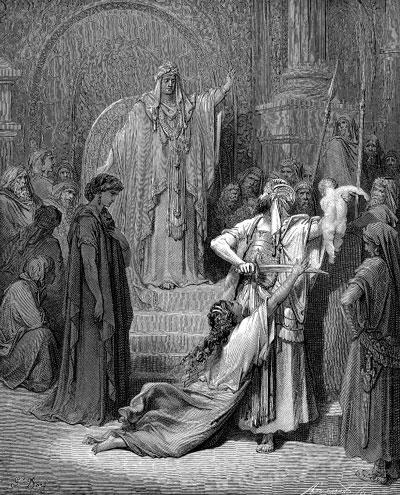
Solomon stands above the crowd, enveloped in sacerdotal excess, neither young nor old, holding out his arms in a melodramatic gesture. He is pontificating rather than judging.
Below, the executioner, the baby and the merciful mother are highlighted. Her hair flying, she lunges toward the baby and the drawn sword, in an effort to thwart the killing. The other mother is in a shaded area; she stands impassively, her hair in place, her arms by her side. Doré portrays her self-interest, rather than her interest in the baby. This is a superficial interpretation of the scene, in our opinion, because Doré has made everything clear, while the story is characterized by ambiguity. Who, in fact, is the “true” mother? How do other works treat the scene?
An enigmatic ivory casket in the Glencairn Museum (Pennsylvania), seems to be from early medieval Spain. On one of its sides, it portrays the Judgment.
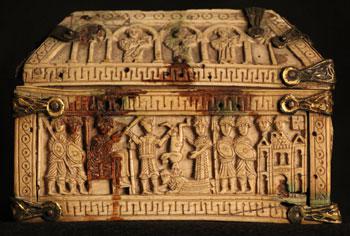
Solomon sits on his throne, rather stiffly. He points with one finger that blends into the upraised sword of the executioner. Thus the moment portrayed here is the king’s command to cut the baby in two. The other side of the casket depicts Solomon riding an ass to his anointing. We suggest that Solomon serves here as a prefiguration of Jesus, coming into Jerusalem on Palm Sunday and judging humanity at the end of days.
The executioner holds the baby cruelly upside down by its leg. One mother lies prostrate before him, grasping at his feet, as if to unbalance him. The other mother stands in shock, one arm helplessly dangling and the other touching the baby. Despite the primitive carving of the ivory, the subtlety of the biblical account has been preserved.
In the “North French Miscellany”, a compilation of various Jewish religious texts illuminated around 1280, Solomon is center stage.
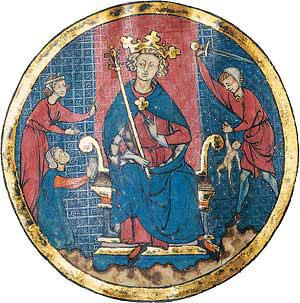
He is enormous on his ornate throne, crowned golden, brandishing his scepter; he eyes the two women piteously. This Solomon is made in the image of the saintly king of Gothic France, Louis IX. He has given the order to split the baby and will make a judgment, but for now he is in a state of perfect equilibrium. The two mothers are placed to the king’s right. One, slightly bent, holds out her arms, her face set as if to say “neither one shall have the child”. The other, kneeling, clasps her hands, pleading for the baby. On the king’s left, the executioner holds the baby by its arm, about to wield the sword. While the identity of the women is clear, it is not central to the painting. The king is the thing.
Raphael’s treatment of the Judgment, found in the papal Stanza della Segnatura, was painted by the artist as a young man. The interest here is not in the narrative, but in the philosophical principles that inform the entire room.
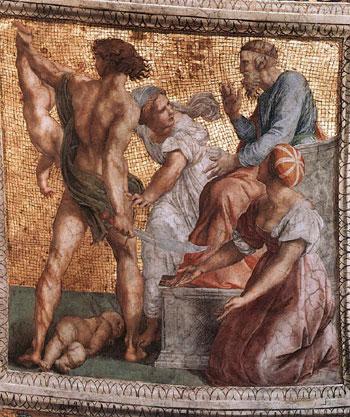
On the left, the executioner holds up the baby by a leg, like a piece of meat; he prepares to wield the sword. In the center, one of the mothers, dressed in white, lunges toward the executioner, to stop the sword, while she looks toward Solomon. The other mother, also looking at the King, kneels at his feet, her arms outstretched as if to surrender. A venerable Solomon calmly gestures, reviewing the confusing testimony. The presence of the painting in this room connotes that its focus is on Justice, in which Law needs to be combined with Mercy.
Nicolas Poussin’s treatment of the judgment is, in our opinion, the best rendition of the scene, because it captures its drama and its ambiguity. As if sitting in the front row of a theater, we immediately see the two mothers, screaming and accusing one another.
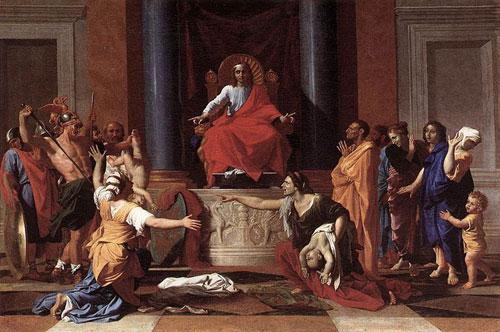
As opposed to all the other treatments of the Judgment, neither one of the mothers is responding to Solomon’s awful tactic. Only when we look up do we see a young Solomon, seated above the crowd, with a halo framing his head: he is Louis XIV, the Sun King. He is pointing in both directions, as if weighing the contradictory testimony. His right hand also leads our eyes to the executioner, holding the baby, as usual, by its leg and about to draw the sword from its scabbard. When we compare the three focal points of the painting to the biblical text, we discover that Poussin has captured three different moments in the drama in one visual image:
22 The other woman spoke up, “No, the live one is my son, and
the dead one is yours!” But the first insisted, “No, the dead boy is
yours; mine is the live one!” And they went on arguing before the
king.
23 The king said, “One says, ‘This is my son, the live one, and the
dead one is yours’; and the other says, ‘No, the dead boy is yours,
mine is the live one.’
A sword was brought before the king, 25 and the king said, “Cut
the live child in two, and give half to one and half to the other.”
Thus Poussin has captured Solomon at the critical moment: how will he judge character?
William Blake’s Solomon dominates the scene both in his position and his colors.
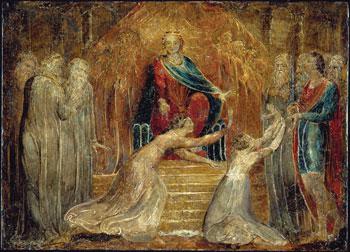
c. 1800
He sits regally on his throne and gestures with one hand to stop the execution and with the other points at the “true” mother. She lunges toward the executioner, her arms forward, one to stop the execution and the other pointing to her rival. She says, “Please, my lord, give her the live child; only don’t kill it!” The other woman coldly holds up the baby to the executioner, as if it were a toy, saying “It shall be neither yours nor mine; cut it in two!” The scene is framed by sympathetic onlookers, whose expressions validate Solomon’s judgment.
When we compare Blake’s treatment of the women to other paintings, we find that he has changed the usual iconography radically, thus capturing the ambiguous quality of the text. Having identified the "true" mother, Solomon is the wise king/judge, in stark contrast to the reigning monarch of England, the insane George III.
The Queen of Sheba
The next most commonly treated scene from Solomon’s life is his meeting with the Queen of Sheba.
In the bible, the Queen comes to Jerusalem to test Solomon’s wisdom and assess his wealth. She is entirely overwhelmed by both. The story is juxtaposed with Solomon’s trade relations with Hiram of Tyre on the one hand and with his multitude of foreign wives, whose idolatry cause his downfall, on the other hand. Here he is completely dominant. Moreover, Solomon is shown to be the wisest of all men, a theme that is further elaborated in later Jewish midrash.
But Jewish and Muslim commentators sought a spicier subtext, creating a sexual tension between the two monarchs that results in the birth of Rehoboam, or Nebuchadnezzar or Menelik of Ethiopia!
The pericope does not appear in any Jewish liturgical context and therefore is not the focus of much Jewish artwork.
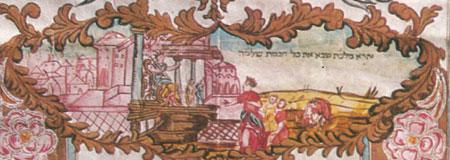
In a ketuba created in Rome in 1771, the Queen of Sheba seeing Solomon’s wisdom, is the centerpiece of the document. It is clearly meant to convey the dominance of the husband over the wife, as do the allegorical figures in the margins of the ketuba.
A carpet, produced in Persia around 1850, has a somewhat different take on the same scene.
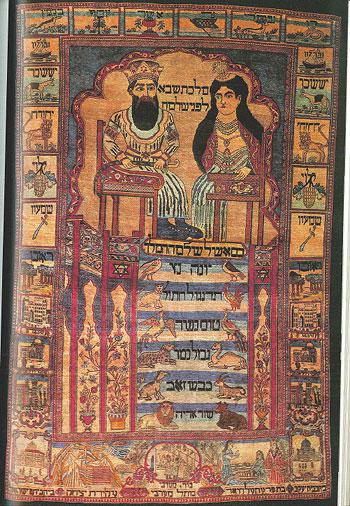
While it includes the Hebrew text “The Queen of Sheba before Solomon”, it actually shows her seated beside him, on the same level. The relationship is more of companions. Both are seated on what is labeled “the throne of King Solomon”, showing pairs of animals on each step and reflecting the text in the Targum Sheni to Esther. They are posed as if for a royal photo opp.
Christianity and Islam are much more interested in the pericope and the character of the Queen of Sheba than is Judaism. In Christianity we have several understandings of the nature of the meeting. In Ethiopian Christianity, the Queen of Sheba is Ethiopian, her name is Makeda, she becomes pregnant by Solomon and the child is the founder of the Ethiopian royal dynasty. This historical approach is elaborated in great detail in the Ethiopian national epic, the Kebra Negast, which was illustrated in much 20th century folk art, including the silk shawl below.
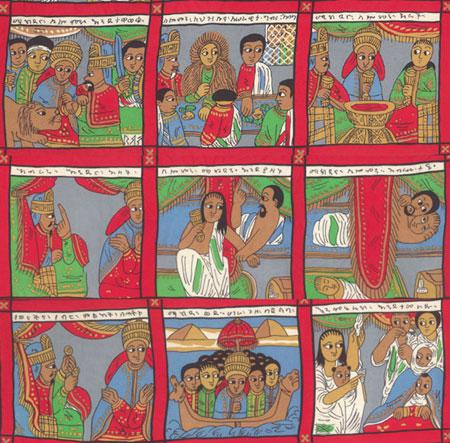
In the first four vignettes shown here (from a much longer account), Makeda meets, dines and is impressed by Solomon’s wealth. Only in the fifth square, they sleep together and Solomon presents her with rings. She returns home and gives birth to Menalik I.
In the few renditions of the meeting between Solomon and the Queen of Sheba in Ethiopian art, she appears as a near equal of the Israelite king.
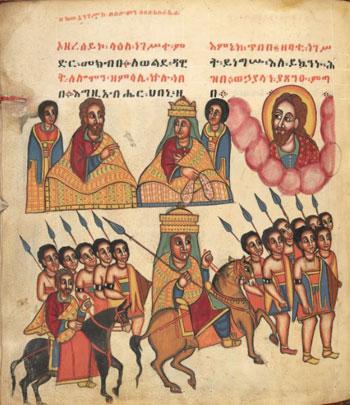
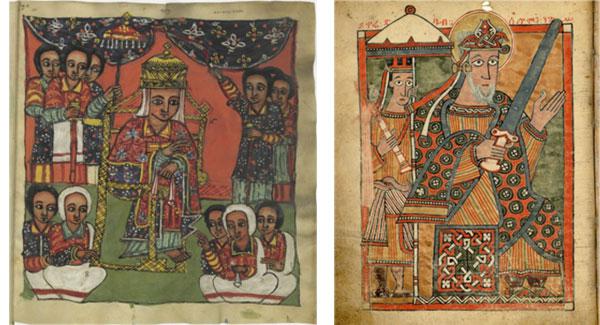
King Solomon
19th century 1468 - 78
It is safe to assume that this parity derives from her identification as the mother of the founder of the Ethiopian royal dynasty. King Solomon appears frequently in Ethiopian art; in the three examples here, he is simply an impressive regal stud. But note how much younger the 19th century artist's view of Solomon is compared with the greybeard of the 15th century.
In European Christianity, the queen is seen in several different ways: as the bringer of offerings to Solomon, presaging the Magi who brought gifts to the baby Jesus; and as a symbol of the Christian church, with Solomon being a type of Jesus.
In this Biblia Pauperum from late 14th century Holland (right), the Queen of Sheba stoops in order to give the seated King Solomon a gift.
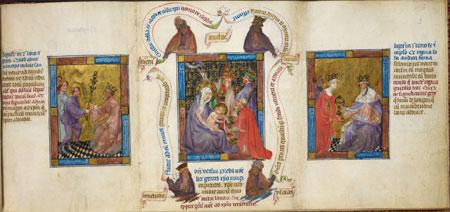
This OT vignette is paralleled in the center by the story of the three Magi, who bring the infant Jesus gifts from the east. It is further compared to the story of Abner, on the left, bringing King David promise of support from his enemies. In sum, the lesson of this page of the Biblia Pauperum concerns gentiles paying homage to Jesus and his ancestors. As such, the Queen of Sheba represents the faithful gentiles, accepting the leadership of Solomon, who represents the Church.
In his Gates of Paradise, Ghiberti places the Queen of Sheba and King Solomon on the same level, holding hands in what seems to be as close to an equal relationship as can be imagined in the 14th-15th centuries.
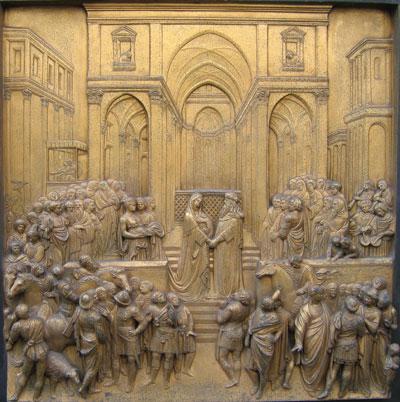
She symbolizes the Church and he, Jesus. Thus the reading of the OT story is one of collaboration rather than of dominance.
In the mid-15th century, the story of the meeting between the Queen of Sheba and Solomon was portrayed by Piero della Francesca in his frescoes on the Legend of the True Cross.
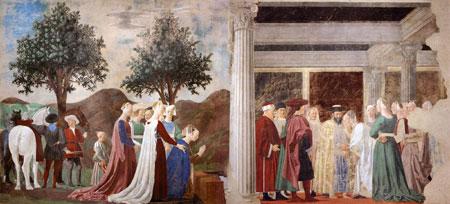
According to Jacobus de Voragine’s Golden Legend, upon which the cycle was based, the queen of Sheba had a revelation regarding the wood of the True Cross, which had been used by Solomon as mere lumber. When she tells him that this wood will be instrumental in Jesus becoming the Savior of the world and therefore end the Jewish Kingdom, he buries it, in order to prevent this happening. In the painting she appears twice: once, kneeling before the wood in adoration and again, sharing her revelation with Solomon. She therefore represents spiritual knowledge, as opposed to Solomon’s material knowledge. She bows slightly to Solomon – so he is dominant, but not overpowering, as in the Biblia Pauperum, but closer to Ghiberti’s interpretation.
In Muslim tradition, Solomon is both the ideal, all-powerful king, seated on his throne, and an Islamic prophet, preceding Mohammed. His meeting with the Queen of Sheba, called Balqis in all the Muslim sources, is already recounted in the Quran and greatly elaborated in later literary and artistic works.
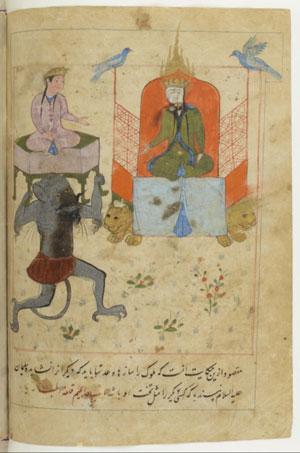
In this picture from a 12th century Persian compendium called “The Wonders of Creation”, Solomon is seated on his throne, flanked by birds and lions. Balqis is being transported on her royal palanquin by a black demon. While she is positioned on the same level as Solomon, her connection with the demon indicates that she is a rival of the king-prophet, who has not yet converted her to Islam.
The next stage of the meeting of Solomon and Balqis is represented in many Islamic manuscripts of the period.
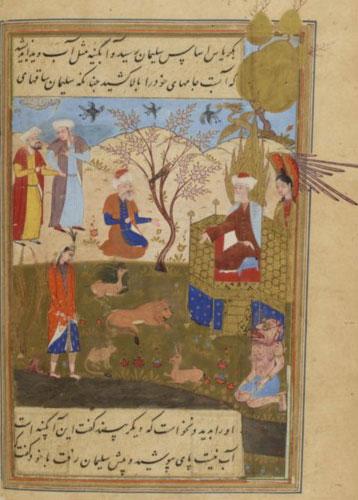
The 16th century Sufi tract “Meetings of Lovers” displays several elements in common with the preceding picture: birds and animals accompany the king, enthroned and haloed. Here too there is a demon. The novel element, appearing also in many of the Muslim and Jewish literary sources, is Balqis lifting her skirt, revealing her hairy legs. She has mistaken the reflection of light in Solomon’s marble floor for a pool of water. This bizarre tale seems to be a put-down of Balqis as a country bumpkin, unfamiliar with the ways of sophisticated, cosmopolitan folk. Note also that here she is standing below the king.
In another 16th century painting, from a manuscript of Thalabi's Qisas al-Anbiya, Solomon and Balqis are seated on separate thrones. Balqis leans slightly toward Solomon, indicating her subservience to him. For now, they are seated apart, but following their marriage and her acceptance of Islam, they will sit together.
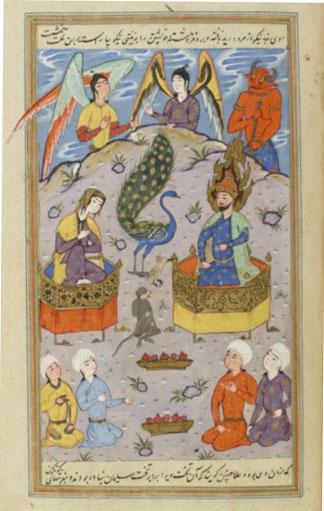
Above them two angels and a demon represent the spirit world. Between them a monkey and a peacock symbolize nature; the peacock further indicating the passion that Balqis and Solomon have for one another. Below the royal pair four dignitaries represent humanity, all under Solomon’s benevolent control.
In summation, in the few Jewish treatments of the story, Solomon is the great king. In Christianity, he is simply the link to or representative of the House of David, from which Jesus emerges. Finally, in Islam, he is the model of the all-powerful, pious Muslim ruler. In all cases, the Queen is simply his dramatic foil.
Solomon's wives, his idolatry and the demise of the kingdom
The final episode in the biblical account of Solomon's reign describes his downfall:
(א) וְהַמֶּ֣לֶךְ שְׁלֹמֹ֗ה אָהַ֞ב נָשִׁ֧ים נׇכְרִיּ֛וֹת רַבּ֖וֹת וְאֶת־בַּת־פַּרְעֹ֑ה מוֹאֲבִיּ֤וֹת עַמֳּנִיּוֹת֙ אֲדֹ֣מִיֹּ֔ת צֵֽדְנִיֹּ֖ת חִתִּיֹּֽת׃ (ב) מִן־הַגּוֹיִ֗ם אֲשֶׁ֣ר אָֽמַר־יהוה אֶל־בְּנֵ֨י יִשְׂרָאֵ֜ל לֹא־תָבֹ֣אוּ בָהֶ֗ם וְהֵם֙ לֹא־יָבֹ֣אוּ בָכֶ֔ם אָכֵן֙ יַטּ֣וּ אֶת־לְבַבְכֶ֔ם אַחֲרֵ֖י אֱלֹהֵיהֶ֑ם בָּהֶ֛ם דָּבַ֥ק שְׁלֹמֹ֖ה לְאַהֲבָֽה׃
(1) King Solomon loved many foreign women in addition to Pharaoh’s daughter—Moabite, Ammonite, Edomite, Phoenician, and Hittite women, (2) from the nations of which GOD had said to the Israelites, “None of you shall join them and none of them shall join you, lest they turn your heart away to follow their gods.” Such Solomon clung to and loved.
As far as we know, there are no extant artistic treatments of this episode before the end of the 12th century. While Solomon's decline is treated in several works of the 13th – 15th centuries, it became a frequent subject of artistic attention only in the 16th and 17th centuries, mainly in Holland. All treatments derive from Christian Europe. Since Solomon is considered the perfect king-prophet in Islam, the biblical account is dismissed as a distortion; as a result there is no Muslim art on the topic. In Jewish tradition, the episode is not part of any liturgical reading and therefore was not treated in any Hebrew illuminated manuscripts.
The subject of Solomon’s foreign wives first appears in the Pamplona and Amiens Bibles of 1197, produced under the direction of a Catholic cleric and intended for the King of Navarre, Sancho el Fuerte; as yet, there is no reference in them to his idolatry.
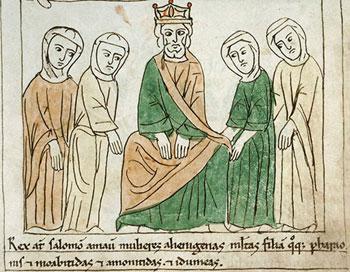
Solomon with his wives
It seems that the motivation for this innovative treatment of Solomon's fall was as an ecclesiastical critique and warning to King Sancho, who pursued a policy of coexistence with Muslim forces and may have even married the daughter of the local Muslim leader.
Only a few decades later, the first portrayal of Solomon kneeling before an idol appears in the Bible Moralisee. The idol is satyr-like, its genitals are exposed, while two women push Solomon to worship it. The king appears here to be naive and is manipulated by the depraved women.
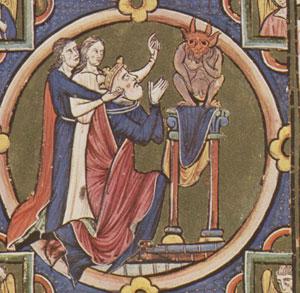
Our scene next appears in the Queen Mary Psalter.
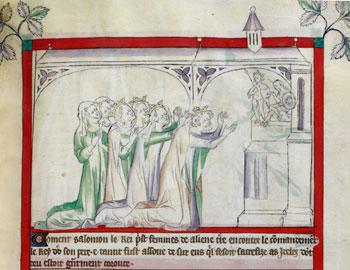
Solomon and his wives worshiping idols
Here the king is kneeling before two male idols, equipped with spears and shields, indicating their military character. Behind him kneel five of his foreign wives, three wearing crowns to indicate their royal status. Who commissioned this manuscript? According to some, it was Queen Isabella, the French consort of King Edward II of England. If so, this is a warning to the king about the dangers of temptation. According to others, the psalter was commissioned by Edward for Isabella. In this case, he may have been hinting at the queen’s foreign birth and warning her against any thoughts of involvement in affairs of state.
In either case, the unusual inclusion of this biblical episode is explained as a cautionary tale regarding Solomon's growing insecurity, which led him to seek foreign alliances and to worship military gods.
Skipping ahead 150 years, still in England, we find Solomon’s idolatry in an illustrated manuscript of the popular didactic poem by John Gower, “Confessio Amantis”.
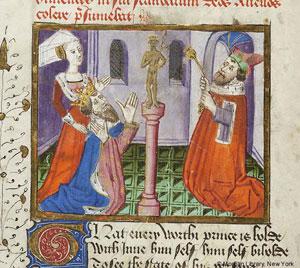
Gower's text, a paraphrase of the biblical account, stresses that Solomon's sexual appetites brought about his downfall.
The manuscript dates to circa 1470 and has been linked to Queen Elizabeth Woodville, the wife of Edward IV, a major figure during the Wars of the Roses.
A nude, armed and crowned male idol divides the picture in two. On the left, a royal lady stands behind the overwrought, kneeling Solomon. She supports and pushes him at the same time. The right side of the scene is dominated by a high priest, who swings a censer, accompanying the ritual. This is the first case we know of the inclusion of a clerical figure in this vignette. Oddly, no priest is mentioned either in the biblical scene or in Gower’s poem. This clerical figure will reappear much later. George Neville, archbishop of York, was one of the important players in the turbulent maneuverings of this period in English history. The inclusion of the priestly figure here may be a hint at Neville's involvement in the political scheming that culminated in Edward's loss of the kingdom. In sum, this picture departs significantly from Gower's poem and focuses on political intrigue rather than carnal weakness as the cause of Solomon's downfall.
Lucas van Leyden is the earliest of the many Dutch artists who treated Solomon’s apostasy. During the 16th and 17th centuries, this scene became much more popular than it had been before and took on new meanings.
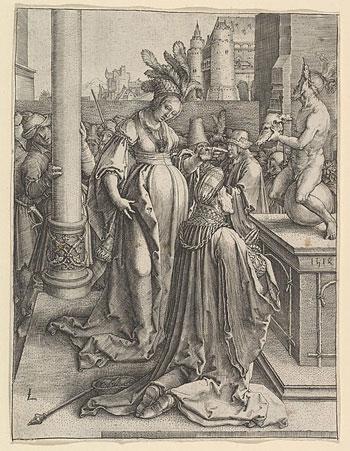
Two figures occupy the center of the engraving. On his knees and visible from the back right, the once powerful king worships a military idol. Towering over him is the imposing figure of his foreign consort, who gestures aggressively toward the idol, her massive headdress further amplifying her dominance. While many of these components have been seen before, the king’s crown and scepter are new. They lie behind him at his feet, like discarded toys. This element certainly is meant as an omen of the fall of Solomon’s kingdom as expressed plainly in I Kings 11:
(יא) וַיֹּ֨אמֶר יְהֹוָ֜ה לִשְׁלֹמֹ֗ה יַ֚עַן אֲשֶׁ֣ר הָֽיְתָה־זֹּ֣את עִמָּ֔ךְ וְלֹ֤א שָׁמַ֙רְתָּ֙ בְּרִיתִ֣י וְחֻקֹּתַ֔י אֲשֶׁ֥ר צִוִּ֖יתִי עָלֶ֑יךָ קָרֹ֨עַ אֶקְרַ֤ע אֶת־הַמַּמְלָכָה֙ מֵעָלֶ֔יךָ וּנְתַתִּ֖יהָ לְעַבְדֶּֽךָ׃
(11) And GOD said to Solomon, “Because you are guilty of this —you have not kept My covenant and the laws that I enjoined upon you—I will tear the kingdom away from you and give it to one of your servants.
Van Leyden’s engraving of Solomon’s apostasy is part of two series illustrating the Power of Women topos, which included Samson and Delilah, Jael and Sisera, and others. In other words, van Leyden saw this story as exemplifying the seductive power of (foreign) women over men.
One hundred and fifty years later, Gerbrand van den Eeckhout, a student of Rembrandt, imagines differently.
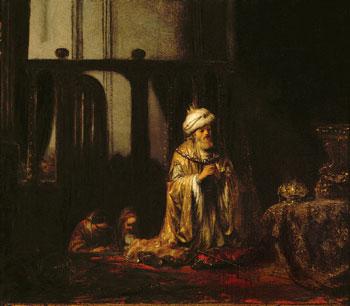
Whereas van Leyden presented us with the public humiliation of Solomon, Eeckhout places the scene within the stillness of a sanctuary.
The king, crowned and weighed down by opulent fabrics, kneels before a gilded altar at the foot of which is a golden censer. In contrast to the prominence of Solomon’s wife in van Leyden’s treatment, Eeckhout places four diminutive, praying women behind and below the king. Finally, the idol itself, so prominent in other versions of the scene, is “off camera” here. Eeckhout was a Mennonite, who rejected worldly excess: In effect, Solomon’s idolatry is the worship of wealth itself.
The subject of Solomon’s apostasy continued to interest Dutch (and other) painters during the 17th and 18th centuries and took on additional connotations.
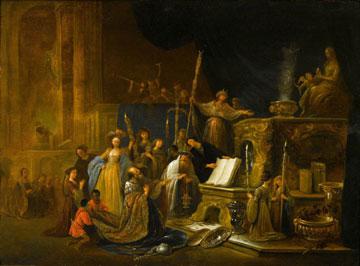
In de Wet’s painting set in a basilica, Solomon kneels in worship before a baroque altar. Using light and shadow, cast by many candles, de Wet directs our attention at a priest, crowned with laurels in the Roman tradition, holding a censer and crouching beside a tome held open on the altar. He looks anxiously at the bare-headed Solomon, kneeling beside him, his crown and scepter discarded on the ground. Solomon's wives are behind him; the main female figure stands elegantly, looking amused, while others kneel piously or gossip. In the shadows above the altar is a large podium where a goddess sits before a bowl of burning incense, holding yet another candle and accompanied by an Eros-figure. Thus, de Wet has taken motifs from earlier renditions of the scene and added many elements of Catholic worship. These details are intended as a Protestant critique of the image-love of Catholicism.
In sum, while European Christians connected the scandal of Solomon’s old age with changing agendas of their own times, both Jews and Muslims ignored the biblical story. Instead, they transformed his behavior into demonic imagery.
Solomon and the demons
Post-biblical literature - Jewish (for example Josephus, Antiquities, VIII, 2.5 and Gittin 68a f.), Christian and Muslim (for example Quran 27: 15f.) - is replete with sources on Solomon and the demons. In some cases, he suppresses them; in others, he employs them. Surprisingly, Jewish and Christian artistic treatments of Solomon and the demons are very rare, while Muslim art on this subject abounds.
Jewish art
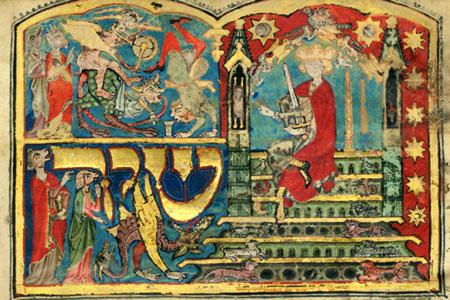
The sole example in Jewish of art of this motif, is an enigmatic picture introducing the Song of Songs in the Kaufmann Tripartite Mahzor of 1322. It shows King Solomon, the traditional writer of Songs, seated on his throne. All agree that the major literary source of the picture is Targum Sheni to Esther, a late midrashic work. But there is disagreement about all of the other elements in the picture. According to B. Narkiss and G. Sed-Rajna, the picture shows the famous Judgment of Solomon (I Kings 3). Solomon is seated on the right on his magical throne, sword in hand, about to split the living child. On the left, below, the two contesting mothers (portrayed in accordance with the practice of the time and place with animal heads!) raise their hands toward the king; above, looking on in wonder, the Queen of Sheba (who actually only appears well after the Judgment, in I Kings 10), is identified by her royal robes and crown. Both above and below on the left there are chimerical figures, playing music and romping as befits a royal audience.
But as S. Shalev-Eyni has pointed out, there are many divergences here from the accepted iconography of the Judgment scene. First, there is no baby here, as in all other portrayals of the biblical scene. Second, in all other pictorial versions of the Judgment, the killing sword is in the hands of the executioner, not in the hands of the King, the man of Peace. Third, the “royal robe” of the woman above on the far left is identical to that of one of the women below, who is, according to Narkiss and Sed-Rajna, a prostitute and her “crown” is, in fact, spiked hair, just like that of the chimerical figure in front of her.
Thus, Shalev-Eyni rejects the identification of the picture from the Tripartite Mahzor as the Judgment of Solomon and sees it as the celestial King Solomon being praised by a group of women and demons. This painting is a joint endeavor of Jews and Christian, combining Jewish and Christian lore and iconography regarding Solomon, the divinely appointed ruler of humans and spirits. As far as we know, this is the only extant Jewish treatment of Solomon and the demons.
Christian art
One of the few Christian artworks associating Solomon and demons is a 15th century illumination illustrating the so-called Book of Belial by Jacobus de Teramo.
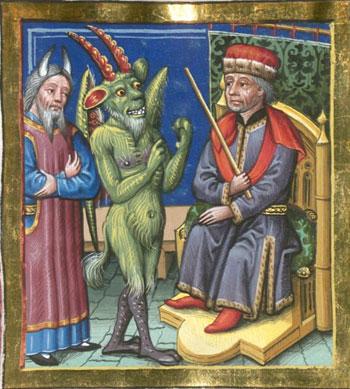
In this picture, King Solomon presides over a suit brought by Satan against Jesus, who has trespassed into Hell. God is not present, nor are Jesus and Satan. They are represented by legal counsel: the horned Moses is Jesus’ defender; a hybrid, surreal demon is the prosecutor and Solomon, holding a scepter, will soon issue the divine decree.
Here, too, as in the Kaufmann Mahzor, the seated King Solomon is superior in status to the standing demon, but this demon, far from being servile, is an aggressive attorney.
Muslim art
In contrast to the paucity of Christian and Jewish art, we can now luxuriate in the riches of Muslim art on Solomon (= Suleyman).
As we have already seen, the Islamic Solomon is the ideal ruler: an all-powerful king and a prophet. He controls humans, animals and even spirits through divine wisdom enhanced by magic. The idealized Solomon, like the idealized Mohammed, controls all, benevolently, but forcefully.
Solomon is often depicted enthroned, sometimes with Bilqis, the Queen of Sheba. He is attended by servants and animals, and even by spirits and especially demons.
In the example below, Bilqis is seated together with the king on his royal throne. They are a couple, because now she has accepted Islam.
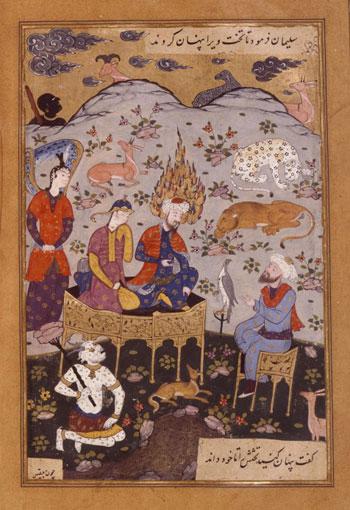
A black demon and a white demon occupy the upper and lower left margin. Their postures indicate their subservience to Solomon. The interior scene is filled with animals, another aspect of his control. Between the two demons, a tall angel stands behind the royal couple, protecting them. Before and below them, sits Solomon’s vizier.
In the same manuscript, Solomon appears off-center on a golden throne.
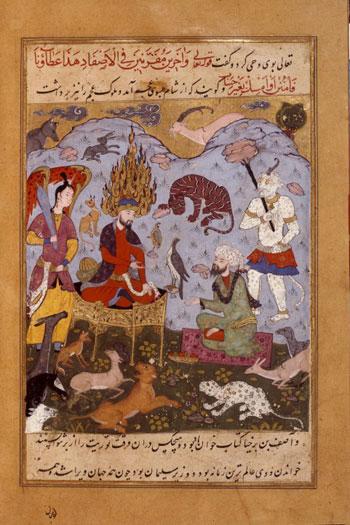
A huge halo of light crowns him. His control is total: a ministering angel, to his right, carrying a club; a grotesque demon, to his far left, is comically reduced to bearing a fan. Animals and birds, possibly symbolic of the nations of the world, surround his throne.
The only other human figure, kneeling before Solomon, may, in fact, be the enigmatic King of the Ants. According to the Quranic story (The ants, 15ff.), elaborated in later Muslim lore, Solomon is reproved and belittled by the ant for his lack of humility and excessive material requests of God. Thus, the painting portrays Solomon’s unlimited power, while the text undermines his so-called wisdom and his might.
In a contemporaneous manuscript, Solomon, once again, appears off center on his elevated throne, flanked by angels, to his right, a pair of demons below and a trio of elders to his left.
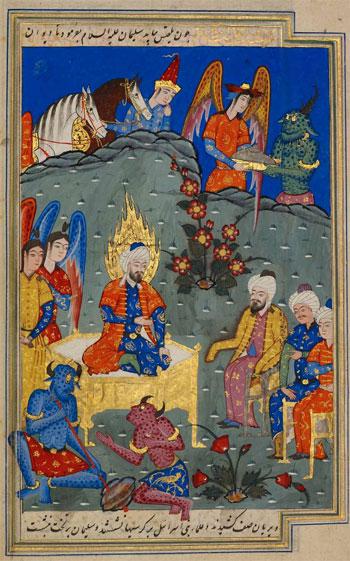
16th century
A trail of flowers leads the eye upward to a different scene. On the right, an angel and a demon are holding a platter. On the left, a young man wearing a conical hat holds two horses in waiting. What is different about this painting from our previous example is the total absence of animals and the increase of spirits (angels and demons) and humans.
In trying to evaluate these pictures, we must ask why are so many demons, angels and animals associated with Solomon in the 15th – 17th centuries? Is there a biblical basis for this tradition? We suggest the following possibilities:
• In I Kings 5:13, Solomon speaks about the animals, but this was understood in Jewish and Muslim lore as he spoke with the animals. Solomon's wisdom is exemplified by his power over and communication with animals and spirits.
• The animals represent the nations of the world, as in Isaiah’s vision (11:1 – 9) of the future messianic era. Animals are also paired with ethnic groups in Jacob’s Blessing (Genesis 49) and in Moses’ farewell (Deuteronomy 32).
• There is an enigmatic phrase in Ecclesiastes 2:8
(ח) כָּנַ֤סְתִּי לִי֙ גַּם־כֶּ֣סֶף וְזָהָ֔ב וּסְגֻלַּ֥ת מְלָכִ֖ים וְהַמְּדִינ֑וֹת עָשִׂ֨יתִי לִ֜י שָׁרִ֣ים וְשָׁר֗וֹת וְתַעֲנֻג֛וֹת בְּנֵ֥י הָאָדָ֖ם שִׁדָּ֥ה וְשִׁדּֽוֹת׃
(8) I further amassed silver and gold and treasures of kings and provinces; and I got myself male and female singers, as well as the luxuries of commoners—coffers and coffers of them.
that some Jewish traditions translate as "male and female demons”.
• The demons in Muslim tradition may represent foreign and pre-Muhammedan gods. All have come under the control of Solomon
• Another possibility is that the demons (and animals?) represent the dark side of human consciousness (the “evil impulse”, the shadow).
Rachel Milstein suggests that the theme of Solomon’s control over animals and spirits served the propaganda of the Persian and Ottoman rulers of the time, who claimed to be the heirs of Solomon. As he controlled all, so should they.
But in some religious traditions, Solomon's world domination is not just political and military, but magical.
In fact, there is tension in traditional literature and art on Solomon between the magical direction (control over nature) and the more orthodox political direction (political and religious power). Orthodoxy (Muslim, Jewish and Christian) is wary of the danger to strict monotheism posed by magic. While there is a desire to elevate Solomon as superhuman, there is also anxiety about deifying him.
In sum, artists have struggled to deal with the biblical account of Solomon’s glorious beginnings and his pathetic downfall. Jews have chosen to ignore the downfall, Christians have reveled in it, contrasting it to Jesus’ saintliness. Finally, Muslims have rejected the biblical narrative of his downfall, replacing it with a magical scenario.



